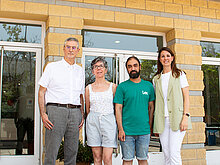Associations between different organisms (“symbioses”) are of vital importance for the development and maintenance of life on the planet. In nutrient-poor ocean areas, associations between algae and atmospheric nitrogen-fixing bacteria make an essential contribution to primary productivity, which is represented by the photosynthetic fixation of atmospheric carbon dioxide. A study by Enrique Flores’ group at the Institute of Plant Biochemistry and Photosynthesis (IBVF), together with Rachel A. Foster, from the University of Stockholm (Sweden), and Mercedes Nieves-Morión, working in both laboratories, investigates this symbiosis. The aim of this study is to delve deeper into the associations between diatom algae, responsible for one-fifth of global photosynthesis on our planet, and atmospheric nitrogen-fixing bacteria, specifically cyanobacteria, which are bacteria that carry out photosynthesis in a way similar to plants.
This work, published in the journal PNAS Nexus and featured on the EurekAlert! portal of the American Association for the Advancement of Science, describes the mechanisms by which diatom algae of the genus Hemiaulus support the activity of nitrogen-fixing cyanobacteria, which live inside the diatom, to the point that these cyanobacteria fix much more nitrogen than free-living cyanobacteria. “This mechanism is based on the active transport of organic carbon (including sugars and amino acids) into the interior of the cyanobacterium, which gives up a large part of nitrogen to the diatom, enabling its growth, resulting in greater photosynthetic activity of the symbiotic system,” says Enrique Flores.
The “Biology of Multicellular Cyanobacteria” group led by Enrique Flores and Antonia Herrero (IBVF), has been working for 40 years on the study of the biology of cyanobacteria, with an emphasis on nitrogen assimilation and cell division and differentiation, addressing aspects such as the regulation of gene expression, membrane transport and intercellular communication in these organisms.
The study was funded by projects from the Swedish Research Agency and was based on the previous experience of the Swedish group in the study of marine associations between diatoms and cyanobacteria and on the extensive knowledge of the Spanish group on the biology of nitrogen-fixing cyanobacteria.
Reference: M. Nieves-Morión, S. Camargo, S. Bardi, M.T. Ruiz, E. Flores & R.A. Foster. Heterologous expression of genes from a cyanobacterial endosymbiont highlights substrate exchanges with its diatom host. PNAS Nexus, Volume 2, Issue 6, June 2023 (https://academic.oup.com/pnasnexus/article/2/6/pgad194/7205781). Featured on EurekAlert! https://www.eurekalert.org/news-releases/993494



